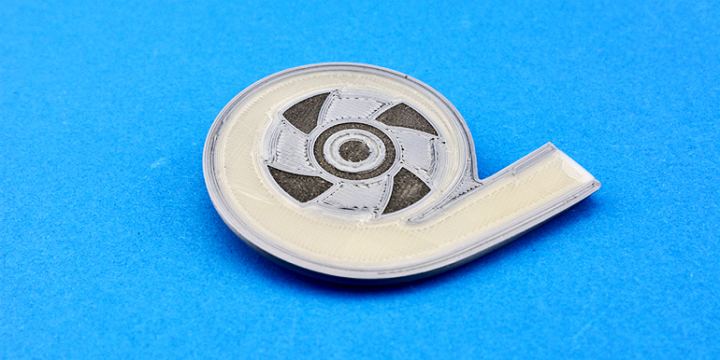Kai von Petersdorff-Campen, a doctoral student in the mechanical and process engineering department at ETH Zurich, set out this spring to make a 3D printed artificial heart pump. He succeeded, though the plastic prototype that took 15 hours to print was not what one would call high quality. But tests showed that the prototype worked, which was important: the more significant point of his project was not actually to make a heart hump, but rather to demonstrate a working application of a 3D printing method he developed that can create products which contain magnets.
Artificial heart pumps are geometrically complex products, as well as contain magnets, and there’s still only a limited amount of research being conducted with 3D printed magnets. The 3D printed heart pump that Petersdorff-Campen developed is one of the first 3D printed prototypes with magnetic components.
Petersdorff-Campen explained, “My goal was not to make a good heart pump, but to demonstrate the principle of how it can be produced in a single step.”
He refers to his new method as embedded magnet printing, as the magnets are 3D printed directly in the plastic. Plastic and magnetic powder are mixed together and processed into filament strands, before they are 3D printed using FDM technology. Then, the print is magnetized in an external field.
According to ETH Zurich, Petersdorff-Campen received an invitation to the prestigious ASAIO conference in Washington this summer. He presented the method in a podium speech, won the prototype competition with his submitted video, and published a paper, titled “3D Printing of Functional Assemblies with Integrated Polymer-Bonded Magnets Demonstrated with a Prototype of a Rotary Blood Pump,” together with colleagues from ETH Zurich, Arnold Magnetic Technologies AG, and the ZHAW Zurich University of Applied Sciences.
(a) Design scheme and coupling of the printed pump with integrated driving and bearing magnets in the housing and impeller; (b) Cross-section of the printed pump showing the used materials in different colors; (c) Fully printed pump with drive unit after removal of support material.
The abstract reads, “In an effort to simplify integration of magnetic components, the current work presents a method to directly print polymer-bonded hard magnets of arbitrary shape into thermoplastic parts by fused deposition modeling. This method was applied to an early prototype design of a rotary blood pump with magnetic bearing and magnetic drive coupling. Thermoplastics were compounded with 56 vol.% isotropic NdFeB powder to manufacture printable filament. With a powder loading of 56 vol.%, remanences of 350 mT and adequate mechanical flexibility for robust processability were achieved. This compound allowed us to print a prototype of a turbodynamic pump with integrated magnets in the impeller and housing in one piece on a low-cost, end-user 3D printer. Then, the magnetic components in the printed pump were fully magnetized in a pulsed Bitter coil. The pump impeller is driven by magnetic coupling to non-printed permanent magnets rotated by a brushless DC motor, resulting in a flow rate of 3 L/min at 1000 rpm. For the first time, an application of combined multi-material and magnet printing by fused deposition modeling was shown. The presented process significantly simplifies the prototyping of products that use magnets, such as rotary blood pumps, and opens the door for more complex and innovative designs. It will also help postpone the shift to conventional manufacturing methods to later phases of the development process.”
One of the biggest challenges of the project, which is part of Zurich Heart under the umbrella of University Medicine Zurich, was actually developing the filaments. The more magnetic powder added to the granulate mix, the stronger the magnet would be, but it would cause the end product to be more brittle; as filaments for 3D printing must be somewhat flexible, this would obviously not work.
Petersdorff-Campen said, “We tested various plastics and mixes, until the filaments were flexible enough for printing but still had enough magnetic force.
“Some people are already asking where they can order the material.”
However, there were people who criticized his 3D printed heart pump, saying that 3D printing should not be used to make medical devices because of all the necessary approval processes they must go through (do any of these detractors actually follow what the FDA is up to anymore?).
But, Petersdorff-Campen is not bothered by his critics, and believes “it’s worth it for scientists and developers to develop the idea further.”
“That was not my focus, however. I simply wanted to show the principle,” Petersdorff-Campen said about his 3D printed medical device.
(a) Polymer-bonded magnetic filament flexible enough to be spooled on a standard filament spool with a 10 cm diameter; (b) SEM micrograph of the extruded polymer-bonded magnetic compound.
While his embedded magnet printing method may not be perfect for fabricating heart pumps, the overall potential for magnetic 3D printing is enormous. Magnets are also used in electric motors, which power all sorts of devices, like microwaves and computer hard drives.
At the moment, geometrically complex components containing magnets are still made with injection molding, but using 3D printing instead could make the process faster and less expensive.
But, Petersdorff-Campen still has a lot of work to do before his new 3D printing method is ready for commercial use. Even though his 3D printed heart pump was able to successfully pump 2.5 liters per minute with 1,000 rotations, it doesn’t quite meet the required standards.
“I wouldn’t want to have such a device implanted,” Petersdorff-Campen said.
Additional co-authors of the paper are Yannick Hauswirth, Julia Carpenter, Andreas Hagmann, Stefan Boës, Marianne Schmid Daners, Dirk Penner, and Mirko Meboldt.
Discuss this story and other 3D printing topics at 3DPrintBoard.com or share your thoughts below.
[Images: Kai von Petersdorff-Campen, ETH Zurich]